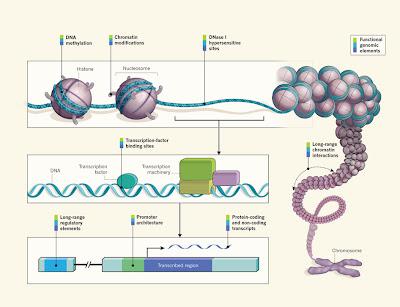 A new wealth of articles by the ENCODE (the ENCyclopedia Of DNA Elements) consortium suggest that far more of the human genome carries out some function or other, and one might conclude that very little DNA is junk:
A new wealth of articles by the ENCODE (the ENCyclopedia Of DNA Elements) consortium suggest that far more of the human genome carries out some function or other, and one might conclude that very little DNA is junk:From an introduction to the new ENCODE papers:
Collectively, the papers describe 1,640 data sets generated across 147 different cell types. Among the many important results there is one that stands out above them all: more than 80% of the human genome's components have now been assigned at least one biochemical function.80%? That is a lot (see [2] for details). It doesn't throw out the idea of junk-DNA, i.e., that there is DNA that has no function - but it puts the number much closer to zero than the 90% that I have heard before. But I seriously wonder what is meant by "function". Take a look at this image[1]:
[Emphasis added.]

Gene regulation is a very spatial thing, which means that if you were to move a gene (i.e., the protein-coding DNA, or exons) somewhere else, then if would probably not be transcribed at the right time. So, if you were to cut out a length of DNA that doesn't have any function, then other DNA will be shifted spatially, and this might screw up proper transcription. So, DNa without function might be important as a filler. On the other hand, ENCODE includes in the 80% everything that is transcribed (i.e., DNA is used to produce RNA), but that doesn't mean that it has a function, as defined in my book. RNA may be floating around in the cell, and may never be translated (into protein), and may not have any other (e.g. regulatory) function either. On top of that, ever if it is translated and a protein is created based on that DNA, it doesn't necessarily follow that the protein does anything (could even be detrimental to the organism), and then that surely isn't functional.
To me, this is one of those moments where my understanding of how things work is challenged. If it really is true that no more than 20% of the human genome is junk (and it apparently could be a lot less than that), then I am happy to update my understanding, but I am super-skeptical that there is that little junk in the human genome. But I am not too happy with the usage of the words junk and non-functional here.
References
[1] Joseph R. Ecker, Wendy A. Bickmore, Inês Barroso, Jonathan K. Pritchard, Yoav Gilad & Eran Segal (2012). Genomics: ENCODE explained Nature, 489 DOI: 10.1038/489052a
[2]The ENCODE Project Consortium (2012). An integrated encyclopedia of DNA elements in the human genome Nature, 489 DOI: 10.1038/nature11247
